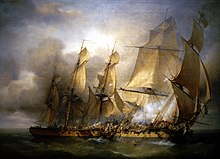Louis-Philippe Crépin
Louis-Philippe Crépin (1772, Paris – 26 November 1851, Paris) was a French
marine painter. Together with Théodore Gudin, he was appointed as one of France's first two Peintres de la Marine in 1830.[1]
Biography

(Action of 14 December 1798)
He studied marine painting with
Joseph Vernet and landscapes with Hubert Robert. Before that, he had been a sailor with four years of experience as a helmsman and gabier (a seaman in charge of the sails). He had his first exhibit at the Paris
in 1796 with "La sortie du port de Brest". He would hold showings there intermittently until 1835.
As early as 1817, he received a letter from the "Ministre de la Marine et des Colonies",
Louis Garneray
.
At the age of fifty-eight, in part due to a bit of self-promotion, he was appointed as one of the first two official marine painters of the French government. That same year, together with the much younger painters
Invasion of Algiers
. His new position eventually became somewhat ceremonial, as he ceased to exhibit in 1836.
His best known painting is "Combat de la frégate française La Bayonnaise contre la frégate anglaise l’Embuscade 14 décembre 1798", which was commissioned by
Versailles by King Louis Philippe I. Since 1935, it has been at the Musée national de la Marine. He also was one of the fourteen artists who contributed to Episodes maritimes, along with Garneray, Gudin, Isabey, Biard
and others, who have largely been forgotten.
References
Further reading
- Haffner, Léon, "Les peintres du département de la marine" in La Revue Maritime, #92, December 1953
- Le Marchand, Jean-Noël, Dictionnaire des Peintres français de la mer et de la marine, Paris, Arts et marine, 1997
External links
Wikimedia Commons has media related to Louis-Philippe Crépin.
- More works by Crépin @ ArtNet
